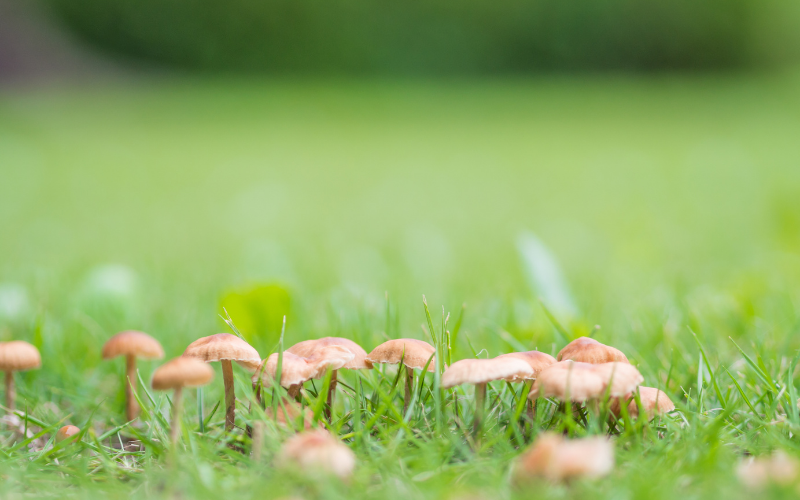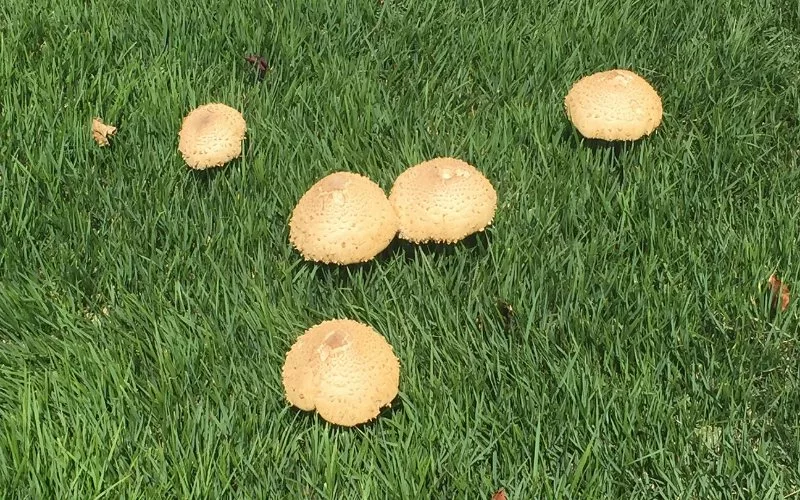Mushrooms in new sod are a great sign. Unlike seeing mushrooms suddenly spring up in an established lawn, mushrooms showing up in sod is very common and not likely to be harmful. If this is the first time you’re seeing mushrooms in your sod, there are a few things you can do to get rid of them quickly and easily.
What Causes Mushrooms in New Sod?
If your sod was installed just a week or two ago, seeing mushrooms here and there is a perfectly natural thing. Most sod has a thick layer of thatch on it. This helps “knit” the sod together, reducing damage during transport, and may make the sod just a little easier to work with overall.
As the thatch breaks down, it creates the ideal conditions for mushrooms and other fungi to settle in. This works the same as it would with an established lawn. After the sod is installed, you typically end up with instructions that include a “watering in” step followed by a few weeks of frequent watering as the sod recovers and begins to take root.
While the sod needs this water and these steps should be followed, doing so creates the perfect environment for fungi. Mold and mildew may be a problem and these can be detected through sight and smell. Mushrooms, however, mean there is an absence of mold and mildew- a good sign.
Why Mushrooms in Sod Aren’t Bad – But You Should Get Rid of Them Anyway
If mushrooms in sod are an indicator that things are going the right way instead of the wrong way, why not keep them? Mushrooms are only the fruiting part of the fungi. Removing the mushroom doesn’t get rid of the fungi in the soil. It’s a bit like picking apples. Just because you remove the apple doesn’t mean the apple tree will die, though it’s unlikely to produce another apple in that same place for a while.
The larger part of the fungi is in the soil. This fungus stretches out threadlike “roots” or runners just a few inches under the soil. This part of the fungi can quickly break down organic matter and turn it into available nitrogen and other nutrients. The sod and grass will feed off of these nutrients, too.
If the mushrooms and the fungi they come from help to break down thatch into nutrients, crowd out more potentially malicious fungi, and provide more access to nutrients, why would you get rid of them? Every benefit must come with a few downsides. In this case, those downsides include the possibility of hydrophobia due to overpopulation of mycelia, and a lack of root development for the sod due to the rich availability of nutrients.
How to Get Rid of Mushrooms in New Sod
Getting rid of the mushrooms on top of the soil will help prevent these downsides while leaving the fungus under the soil to continue assisting your sod and the microbiome of your soil. Alternatively, you could use a fungicide to get rid of the mushrooms and the underground parts of the fungi, but you would be giving up any benefits as well if you do this.
I’ll talk through some of the options you have available below.
1) Fungicide Application to Kill Mushrooms and Underlying Fungi
Applying fungicide should be your last choice as it can damage the health of your soil as well as your new sod. If you must, always apply the fungicide according to the manufacturer’s directions. It should completely kill all fungi, including any visible mushrooms, in as little as 4 hours.
2) Rake Up Mushrooms
Raking up mushrooms is a good choice if your sod is less than 6 weeks old or you do not want to disturb it with mowing. Use any lawn rake or leaf rake that is capable of breaking off the mushrooms. The raked-up mushrooms may be disposed of as yard waste or composted.
3) Mow Off Mushrooms
Mushrooms may be mown off with a typical lawnmower at a standard 2-inch setting. While mowing sod that has only been installed for a few weeks is discouraged, mowing mushrooms off once your sod is rooted and growing will keep their numbers down with no additional harm to your sod.
4) Hand Pick Mushrooms
This is a labor-intensive approach but one that is gentle on new sod. If you do hand-pick any mushrooms, be sure to wear gloves, keep your hands dry, and always pick the mushroom as close to the ground as possible.
5) Reduce Water
Reducing how much water you give to your lawn each day or how often you water your new sod can reduce the number of mushrooms in your new sod or eliminate them. To grow, mushrooms will need the thatch layer of your new sod to stay completely moist.
How to Prevent Mushrooms from Growing in New Sod
There are 2 primary methods for preventing mushrooms from colonizing sod. The first is to apply a chemical fungicide. This will kill all of the spores and fungi in, on, and around your new sod. However, using a product like this may also degrade the quality of your soil and its microbiome.
The alternative method would be to rake the sod lightly and shortly after it is installed, to clean up any excess thatch and fluff up any that remains. This will help mix air into the thatch layer, discouraging the production of mushrooms. It’s also important to stick to the watering schedule you have been provided with by the sod farm or distributor. After the first few weeks, however, you should start the transition to a deep watering schedule.
A deep watering schedule will encourage your sod to root deeply and quickly. Deep watering also discourages the production of mushrooms as they need a constant supply of moisture or a damp environment.




I have a small 2-year-old Yorkie who loves laying in the new sod and recently had to be treated for a yeast ear infection. Could this likely be caused by new sod? Also, I have a wide variety of mushrooms, and lots of them coming up daily. This is NM monsoon season and so they are everywhere in my lawn. Would these be harmful to my Yorkie, because I found a pile of chewed-up mushrooms while picking them out of my lawn? He also has had vomiting inside the house. I’m scared he may be poisoned. Any thoughts or ideas for me.
Hi Sandra,
I am sorry to hear about your situation and hope your Yorkie is doing okay. If your pet has vomited for any reason, especially if your pet’s vomit is yellow, green, or foamy, it needs to be seen by a vet.
Most lawn mushrooms are not poisonous to pets or people, but there is always a chance that a poisonous mushroom could appear in just the right conditions. High winds increase this chance. If possible, take these chewed up mushrooms to the vet with you.
Further, though the new sod should not cause a yeast ear infection, high humidity or water near or on the ears can. Even regularly rolling around on dewy grass can lead to yeast problems in the ears of small dogs and cats if they are not dried off afterward.
Tom.
Hi Tom,
I had my property resodded with zoysia 4 weeks ago and would like to know what you recommend on the watering schedule for central Florida.
I have been getting enough mushrooms and just reduced my Irrigation to every
3rd day for 18 minutes each zone. Can you give me your advice it would be greatly appreciated.
Thank you
Andrew